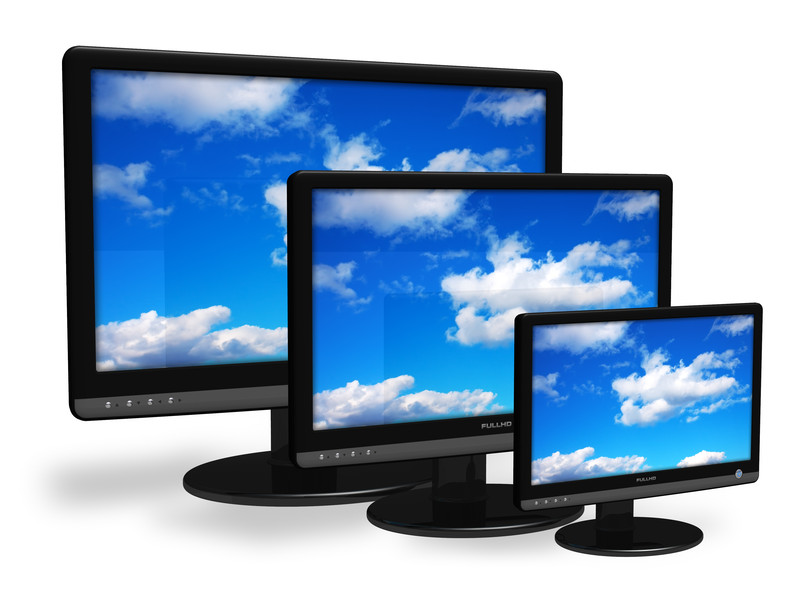
Buying A New TV??? A Help Guide
posted in Information guides by Kelly on 20:52 Sep 23rd, 2015
These days a new TV is not a straightforward easy purchase to make. The choices have dramatically increased and it is no longer just a matter of picking a size and weighing up options of black and white and that new fangled colour picture malarky. In the modern world trying to pick out what to buy can leave you frazzled and confused so to make things a little easier we would like to offer some words of advice and explain what some of the terms mean. We also offer other guides that explain more about the different types of TV if you are interested. These are brought to you free of charge and can be printed for your reference. Reproduction for use other than personal reference, however we would not be happy about nor would the owners of the copyright on the pictures used. We paid a licence fee to use them and so should you!
If you are feeling somewhat overwhelmed please read on and see if this guide helps. If you want any further information, wish to provide feedback or comments or feel the need to add anything then drop me an email or give us a call. I will happily chat to you and help where possible.

So what do you really need??
The selection available today is ever increasing and you can pick up anything from a cheap large screen set to a comple one that is going to give you the full cinema style experience and everything except your dishes and making you cups of tea! The big question is what do you really want the TV to do for you? Do you really need a Tv that is more intelligent than you are or are you just playing keeping up with Jones's with the people over the way?? Generally the more complex that set is the more there is to go wrong and cause issues when the set starts to fail. In some cases the inbuilt software is so glitchy they will go wrong very early in their life. It is usually a matter of research and comparing sets to get the best you can. Many supermarkets now sell TV equipment but this is generally of a low quality and of generic build with a very flimsy warranty. Make sure you know that wherever you buy from offers a decent after sales service.
The first point to consider.........BUDGET!
The more complex the TV is the more likely it is to cost and hurt the pocket. Like I said supermarket TVs are generally cheaply made and sold to maximise profit. In this modern age planned obselence is a well known fact and you can be certain that you will be replacing that TV after 18months so it is just out of the warranty period. This is due to the parts and components used to make the TV are of low grade and are made to last long enough that they will just out last the warranty and then you replace it as the TV was cheap when you brought it so what more are you to expect after all??!! Personally I would rather settle for a slightly less feature packed TV but one that is built to last and thus offers the best return on investment. Another point to consider here is that Argos, Supermarkets and even John Lewis have models of TV that are made uniquely for them and this can make spares expensive and hard to come by. This just adds to the fact that we add to landfill with our electrical waste as it is cheaper and easier to replace the set than to repair it. Many of these stores also have their own spares departments and thus as the parts cannot be found elsewhere you are stuck with using them too. So remember when the dog chews the remote as a new shiny toy that replacing it could be a bit of a trial. Trying to change the channel by pressing the dog's belly is not going to work either!!
At Sivill Service this planned obselence goes against our ethos. We will only sell brands, models and goods that we know are built to last and our customers will be happy with. We offer an in-house warranty of a year on most products but on some bigger and more costly products we will offer 2 years warranty. We are confident in our products and unlike some major retailers if one of our products goes wrong 3 hours out of warranty we will not tell you that it is not covered. We will still look after you as best as we can.
3D or not 3D??
These days there is sooooo much hype over 3D. The big question is - do you really need it? Currently TV technology means that you have to have glasses in order to view the 3D picture. These are not the ones that used to have coloured lenses that came on the back of your cornflakes packet. Instead they are complex and expensive and everyone wanting to see the 3D image would need a pair. Some of these glasses can be around £75 a pair to buy and when you need 10 pairs to cover the family, dog, cat and any mates that may visit, it can soon cost more than the TV. And that is before a single pair gets sat on or dropped and don't even get me started on how annoying it is when they become scratched because the 5 year old in the house has not put the glasses back in the case yet again.
In order to get anything in 3D you also need a 3D source. This means that in practice you need SKY 3D or a 3D Bluray player or games console that is 3D compatible. This can be yet another expense. So the big question is...... do you need it and are you going to use it in reality?? Or do you just a 3D TV to show off your mates over a pint on a Sunday afternoon. A 3D TV can cost more than a non-3D equivalent too.
Smart??
No we do not mean are you smart! Yes, we are referring to the TV and asking just how clever is it?? In this day and age your TV can do MANY things that used to be done by a computer and some of which were simply unheard of. Smart refers to your TVs ability to connect to the internet either using a cable, inbuilt wireless card or USB wireless adaptor. Once connected to the world wide web you can use it to view Netflix, Amazon Prime Videos (used to be LoveFilm) or to browse the internet. On some sets you can also download and install apps (applications - little bits of software that allow you to do things like you will find on iPads or Samsung Galaxy Tabs). These apps allow you to do many things and the world really does become your oyster. These can include taking exercise classes, games, Skype and internet TV channels. Services such as Netflix and some of these apps may carry a charge. By the way Netflix is what is called a streaming service and you pay a subscription to allow you to access film and TV series content via your internet connection whereby you do not download the file to keep but view it in real time.
Would this be of any help or use to you?? Is it just another gimmick that you don't really understand let alone have any use for? It is worth considering as this can drastically impact upon how much of your money you need to part with. In order to access the internet you may need to buy a USB adaptor to make the TV wireless and these can range from £30 upto £200 on some TVs. The other option is to run an ethernet (internet cable that plugs into your router (the internet box)) cable into the TV but this can depend on how far away your router is from the TV. Some people are funny about having cables all over the house.
HD? What is all the fuss about? What is 4K and do I need it?
TV technology has developed so much that is really is at a pivotal point at the present time. The quality of the display of even cheap sets is now great in comparison to an old boxy CRT set like your grandparents used to own. The difference is immense. 90% of modern TVs are HD. How good that HD is can vary. Let me just clarify what this means to you. HD ready TV sets that generally include cheaper models have a maximum resolution of 720p HD. Lately even some top flagship models of TV have taken this step back to being 720p HD rather than full HD - a rather bizzare move. Full HD means that the screen has a maximum resilution of 1080p. A full HD set has over 5 times the picture definition that HD ready sets have. The resolution on a full HD television is 1920 x1080 pixels. Pixels are the tiny dots that make up a screen. A full HD can give a massively high quality image and you will spot things in film and TV that you have never seen before.
Now the downside...like 3D you need a HD source in order to get a HD picture. This stays true regardless of whether the TV is 720 or 1080 HD. This HD source can come in the form of Freeview HD, Freesat HD, Sky HD, games consoles, HD DVD or bluray players or computers with a HD graphics card. Even playing normal DVDs or TV when you connect one of these sources to the TV via a HDMI cable, the TV will do what is called upscalling of the image giving greater clarity and quality to what you are watching. It is not to the level of HD but the difference is noticeable. It is like comparing a VHS tape to a DVD. Bluray players that play normal DVDs too have dropped in price to the point you can pick a cheap one up for very little money. These too can sometimes be smart and wireless! At the current time there are very few channels that broadcast in full HD. Many HD channels only broadcast at 720 due to the size, time for broadcast and required bandwith.
HD is one thing that I would agree is worth ensuring a TV has. Preferably full HD. The difference that this makes to the quality of the picture you see is phenomenal. I can still remember watching a Disney Movie on bluray on a 1080p TV for the first time and spotting things that I would never have seen on a normal DVD. The colours are more vibrant. Lines more crisp and the image so much better to view.
The BIG question - what size TV?
The general rule for this seems to be the bigger the better! Generally people want the biggest TV that they can get, especially blokes who like to compare with their mates over who has the boggest and best TV. Bigger does not always mean better as you have seen. There are other factors to take into account. TV technology is not produced with the aim that you are sat on top of the world's biggest TV. Each different size of TV has an optimal viewing distance. This is a measure of how far away from that set you should be in order for the technology to come into its own and for you to get the maximum and best picture possible. Too close can be as bad as too far away. Getting the distance correct is important so grab yourself a tape measure and do a bit of calculating. Firstly measure the distance that you sit away from your TV and then compare the info to the data below to select the most approriate size of TV for your room. This guide will help to prevent the picture looking blurry, pixelated or watching too small a TV meaning that you cannot see anything without the assistance of a giant telescope from NASA!!!

As a general guide measuring from your comfy armchair to the place where your TV will proudly be taking up residence:
1.2m - 1.8m from TV to armchair you will get the optimum picture quality from around a 26" set (this is screen size measured from corner to corner only taking into account the screen not surround)
1.8m - 2.7m from TV to your comfy spot indicates a TV upto 40" but greater than a 26" would be best suited for your situation
2.7m - 3.5m from the TV you should be looking over a 40" set and up to a maximum of 46"
3.5m - 3.96m from the TV you are into the area where most people start looking. This means you should be looking at any TV upto 55" in size but not less than 46" to avoid distance being an issue.
Over 4m away from the TV to where you sit and the sky really is the limit. At this distance you could purchase a really HUGE TV. Anything up to 72" in size would not look out of place.
This information is only a guide and many people will choose to ignore it working on the bigger the better philosophy, but we hope that it helps you in your decision in selecting the correct TV for your needs. Personal preference, budget and the offers that are around at the time will all still factor in. If we can be of any more help then do not hesitate to contact us and we will offer help and advice where we can. Feedback is also appreciated too!!!














